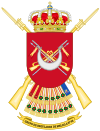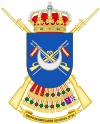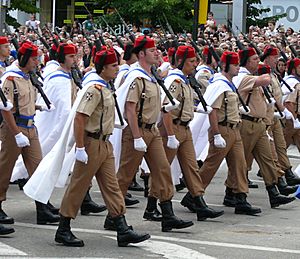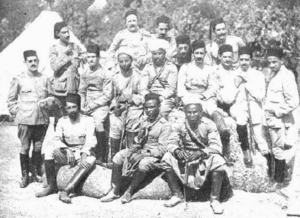Regulares facts for kids
Quick facts for kids Indigenous Regular Forces |
|
|---|---|
| Fuerzas Regulares Indígenas | |
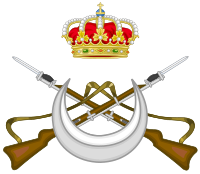
Regulares Badge
|
|
| Active | 1911–present |
| Country | |
| Allegiance | Felipe VI, Spain |
| Branch | |
| Type | Infantry |
| Role | Vanguard troops |
| Garrison/HQ | Ceuta, Melilla, Peñón de Vélez de la Gomera, Alhucemas and Islas Chafarinas. |
| Motto(s) | Fiel Regular hasta morir (Faithful Regular till death) |
| Anniversaries | 12 October |
| Commanders | |
| Notable commanders |
Dámaso Berenguer, José Millán-Astray, José Enrique Varela |
The Fuerzas Regulares Indígenas (which means "Indigenous Regular Forces"), often called the Regulares (Regulars), are special infantry units in the Spanish Army. Most of their soldiers are volunteers from the Spanish cities of Ceuta and Melilla.
These troops were first recruited in Spanish Morocco. They were part of the Army of Africa. Spanish officers led them. The Regulares played a very important part in the Spanish Civil War from 1936 to 1939.
Contents
History of the Regulares
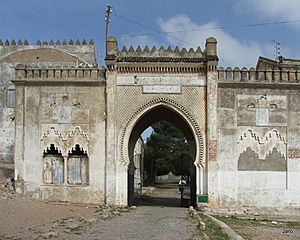
How the Regulares Started
The Regulares began in 1911 as a single infantry battalion. Spain was expanding its army into Morocco from its old coastal cities like Ceuta and Melilla. Before this, Moroccan helpers were used as scouts. The name "Regulares" showed that this new force was a permanent part of the Spanish army.
Spanish officers and some non-commissioned officers joined the Regulares. By 1914, four large groups, called Grupos (like regiments), were ready for duty. While most Regulares were infantry, they also had cavalry units. This was because Moroccans were skilled horsemen. Each Group had a main office, two infantry battalions (called Tabors), and one cavalry squadron (also called a Tabor). They also had a military band.
From 1914 to 1922, the Regulares grew to five Grupos. These were based in Melilla, Tetuán, Ceuta, Alhucemas, and Larache. The Regulares infantry were known for moving secretly across open land.
Regulares in the Rif War
During the Rif War in the early 1920s, most Moroccan troops stayed loyal. The Regulares and the Spanish Legion became the best units in the Spanish Army. They were professional soldiers who were often in action. Many top officers wanted to join them.
One famous officer was Francisco Franco. He served with the Regulares starting in 1913. Later, he moved to the new Spanish Legion. In 1923, some Regulares even guarded the Royal Palace in Madrid. This showed how important they had become. In 1934, the Regulares helped the government stop a miners' uprising in Spain.
Regulares in the Spanish Civil War
In 1936, the Spanish "Army of Africa" joined General Franco's rebellion. This army included 30,000 soldiers from the Legion and the Regulares. At the start of the Spanish Civil War, many Moroccan troops and legionnaires were flown across the Strait of Gibraltar. Germany and Italy helped with this airlift.
These troops became the main attack forces for Franco's side. Their skill and toughness helped Franco win many early battles. As the war went on, five more Regulares infantry grupos were formed. Two cavalry grupos were also created.
The Regulares were excellent fighters in open areas. They advanced from Seville to Madrid in 1936. However, they were not as good at fighting in cities. As more Spanish forces joined Franco, the Regulares' main role changed. But they remained key attack troops until the war ended. In Franco's victory parade in Madrid in 1939, the Regulares were highly honored. They were the most decorated units on Franco's side. The Army of Africa grew to about 60,000 soldiers during the war.
After the Civil War
After Franco won the war, the Regulares became smaller but kept their structure. Franco created a special mounted guard unit from the Regulares cavalry. These guards wore colorful Moorish uniforms and rode white horses. They served close to Franco as part of his personal guard.
When Morocco became independent in 1956, most Moroccan Regulares soldiers joined the new Royal Moroccan Armed Forces. About 12,500 soldiers left. The two cavalry units were disbanded. The number of Regulares Groups was reduced to eight. In 1957, Franco's "Moorish Guards" were replaced by Spanish cavalry. These new guards still wore the white cloaks and rode white horses like the Regulares.
Regulares Today
Spain kept the cities of Melilla and Ceuta. The smaller Regulares Groups from Tetuan, Melilla, Ceuta, and Alhucemas stayed in these garrisons.
In 1986, the Spanish Army reorganized. The four Regulares Groups became two light infantry regiments. These regiments are still part of the Spanish Army today. Their soldiers are mainly Spanish citizens. Many are from Ceuta and Melilla, including both Muslim and Christian people. They still use the traditional names of Grupos (regiments) and Tabores (battalions):
- Grupo de Infantería Ligera Regulares de Melilla nº 52 (Stationed in Melilla, Peñón de Vélez de la Gomera, Peñón de Alhucemas and Islas Chafarinas)
- Tabor Alhucemas I
- Tabor Rif II
- Grupo de Infantería Ligera Regulares de Ceuta nº 54 (Stationed in Ceuta)
- Tabor Tetuan II (motorized)
- Anti-tank company
Both of these regiments also carry on the history of older Spanish Army infantry regiments. In recent years, Regulares units have served in peacekeeping missions. They have been to places like Bosnia and Afghanistan.
Evolution of Regulares Units
In 1914, the Regulares forces grew. They created four regiments, called Groups (Grupos). Each of these four groups had a main office. They also had two Infantry Tabors (battalions) with three companies each. Plus, they had one Tabor of three cavalry troops or squadrons. They also had support units.
The first Groups of Indigenous Regular Forces were:
- 1st Group of Indigenous Regular Forces "Tetuán" (in Tetuan)
- 2nd Group of Indigenous Regular Forces "Melilla" (in Melilla and Nador)
- 3rd Group of Indigenous Regular Forces "Ceuta" (in Ceuta)
- 4th Group of Indigenous Regular Forces "Larache" (in Arcila and Larache)
In 1921, after the Battle of Annual, a fifth unit was created:
- 5th Group of Indigenous Regular Forces "Alhucemas" (with its main office in Segangan)
After the Spanish Civil War, five new groups were formed:
- 6th Group of Indigenous Regular Forces "Xauen" (in Xauen)
- 7th Group of Indigenous Regular Forces "Llano Amarillo" (in Cabrerizas, Mellilia)
- 8th Group of Indigenous Regular Forces "Rif" (in Souk el Had, Beni Sicar)
- 9th Group of Indigenous Regular Forces "Arcila" (in Alcazarquivir)
- 10th Group of Indigenous Regular Forces "Bab-Taza" (in Bab-Taza)
Two cavalry groups were also created. Each had a main office and three Tabors of cavalry squadrons:
- 1st Group of Indigenous Cavalry Regular Forces Tetuán
- 2nd Group of Independent Indigenous Cavalry Forces Melilla
Regulares Uniforms
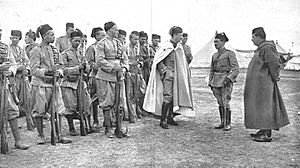
At first, the Regulares wore traditional white Moroccan clothing. Soon after, they got new uniforms. These were like those worn by French zouaves. From 1913-1914, their uniforms changed to simple light khaki. They wore red fez caps and sashes.
In the 1930s, the Regulares wore uniforms similar to the Tiradores de Ifni. Native officers and soldiers wore a tarbuch (a type of fez). They had sand-colored shirts and pants, with brown leather gear. Spanish officers wore a sand-colored version of the standard Spanish Army uniform. They also had a red-topped peaked cap.
Today, the Regulares wear the same camouflage uniforms for daily duties as the rest of the Spanish Army. But they also have a special khaki tropical uniform for parades. The most unique parts of their modern parade uniform are the red fez, red or blue sashes, and white cloaks (called burnous). These come from the Moorish-style uniforms they wore before 1956.
Military Music and Parades
Regulares Military Music Units
The military bands and Corps of drums of the Regulares regiments are known as the Nubas. They are like other Spanish Army bands. However, their Corps of Drums includes drums, cymbals, tambourines, bugles, trumpets, bagpipes, and chirimias (oboes). Today, you mostly see the Corps of Drums performing.
The Nuba used to be led by a Bugle Major. But in 2014, the Corps of Drums of the 54th Regulares Group started being led by a drum major again. This was a practice from their early days. The musicians in the Nuba wear the same uniforms as their fellow soldiers.
Awards and Honors
The Regulares units have received many awards and medals from the Spanish government. This is because of their role in "pacifying" Morocco and their part in the Spanish Civil War. Today, the Regulares are the most decorated units in the Spanish Army.
Some of their many important awards include:
- Laureate Cross of San Fernando: This is a very high military honor.
- Lieutenant Samaniego received it in 1912. He was the first Regulares soldier to get this award.
- Lieutenant Salustiano Sáenz de Tejada y Olózaga received it for his bravery in 1924.
- Laureate Cross of San Fernando (Collective Medal for Units): This is given to entire units for their bravery.
- The II Tabor of the 5th Group of Alhucemas received it for actions in Madrid in 1936.
- The V Tabor of the 3rd Group of Ceuta received it for actions in Madrid in 1936-1937.
- Collective Military Medal: This is another important medal for units.
- The 4th Group received it for an action in 1920.
- The 3rd Group of Ceuta received it for battles in 1921.
- The 2nd Group of Melilla received it for actions in 1923.
- The 1st Group of Tetuán received it for battles at Peñas de Cayat.
- The 5th Group of Alhucemas received it for battles in Madrid in 1936.
- The V Tabor of the 2nd Group of Melilla received it for their actions in the Battle of the Ebro in 1938.
- The V Tabor of the 3rd Group of Ceuta received it for their brave actions in Teruel and the Ebro in 1938.
See also
 In Spanish: Regulares para niños
In Spanish: Regulares para niños
- Spanish Army
- Army of Africa (Spain)
- Tiradores de Ifni, a similar force raised in Ifni
- Guardia Mora
- Goumier
- Spanish Legion
- Mohamed Meziane


